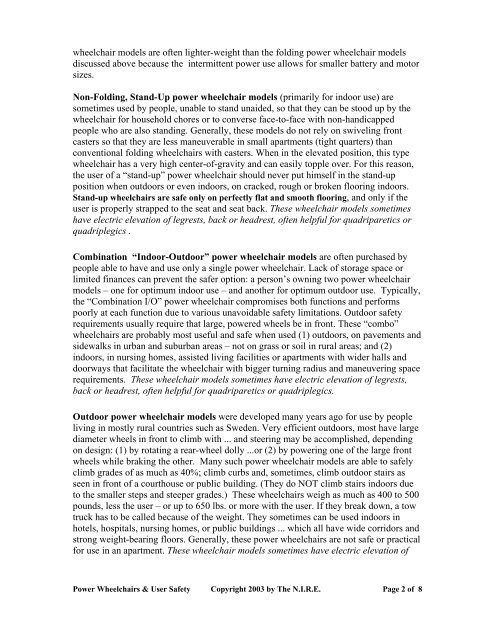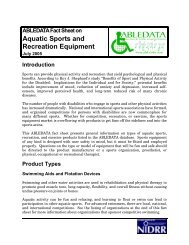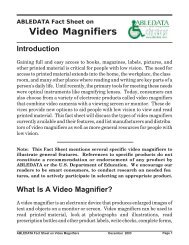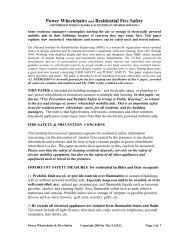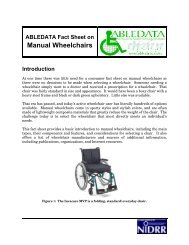Power Wheelchairs and User Safety - AbleData
Power Wheelchairs and User Safety - AbleData
Power Wheelchairs and User Safety - AbleData
Create successful ePaper yourself
Turn your PDF publications into a flip-book with our unique Google optimized e-Paper software.
wheelchair models are often lighter-weight than the folding power wheelchair models<br />
discussed above because the intermittent power use allows for smaller battery <strong>and</strong> motor<br />
sizes.<br />
Non-Folding, St<strong>and</strong>-Up power wheelchair models (primarily for indoor use) are<br />
sometimes used by people, unable to st<strong>and</strong> unaided, so that they can be stood up by the<br />
wheelchair for household chores or to converse face-to-face with non-h<strong>and</strong>icapped<br />
people who are also st<strong>and</strong>ing. Generally, these models do not rely on swiveling front<br />
casters so that they are less maneuverable in small apartments (tight quarters) than<br />
conventional folding wheelchairs with casters. When in the elevated position, this type<br />
wheelchair has a very high center-of-gravity <strong>and</strong> can easily topple over. For this reason,<br />
the user of a “st<strong>and</strong>-up” power wheelchair should never put himself in the st<strong>and</strong>-up<br />
position when outdoors or even indoors, on cracked, rough or broken flooring indoors.<br />
St<strong>and</strong>-up wheelchairs are safe only on perfectly flat <strong>and</strong> smooth flooring, <strong>and</strong> only if the<br />
user is properly strapped to the seat <strong>and</strong> seat back. These wheelchair models sometimes<br />
have electric elevation of legrests, back or headrest, often helpful for quadriparetics or<br />
quadriplegics .<br />
Combination “Indoor-Outdoor” power wheelchair models are often purchased by<br />
people able to have <strong>and</strong> use only a single power wheelchair. Lack of storage space or<br />
limited finances can prevent the safer option: a person’s owning two power wheelchair<br />
models – one for optimum indoor use – <strong>and</strong> another for optimum outdoor use. Typically,<br />
the “Combination I/O” power wheelchair compromises both functions <strong>and</strong> performs<br />
poorly at each function due to various unavoidable safety limitations. Outdoor safety<br />
requirements usually require that large, powered wheels be in front. These “combo”<br />
wheelchairs are probably most useful <strong>and</strong> safe when used (1) outdoors, on pavements <strong>and</strong><br />
sidewalks in urban <strong>and</strong> suburban areas – not on grass or soil in rural areas; <strong>and</strong> (2)<br />
indoors, in nursing homes, assisted living facilities or apartments with wider halls <strong>and</strong><br />
doorways that facilitate the wheelchair with bigger turning radius <strong>and</strong> maneuvering space<br />
requirements. These wheelchair models sometimes have electric elevation of legrests,<br />
back or headrest, often helpful for quadriparetics or quadriplegics.<br />
Outdoor power wheelchair models were developed many years ago for use by people<br />
living in mostly rural countries such as Sweden. Very efficient outdoors, most have large<br />
diameter wheels in front to climb with ... <strong>and</strong> steering may be accomplished, depending<br />
on design: (1) by rotating a rear-wheel dolly ...or (2) by powering one of the large front<br />
wheels while braking the other. Many such power wheelchair models are able to safely<br />
climb grades of as much as 40%; climb curbs <strong>and</strong>, sometimes, climb outdoor stairs as<br />
seen in front of a courthouse or public building. (They do NOT climb stairs indoors due<br />
to the smaller steps <strong>and</strong> steeper grades.) These wheelchairs weigh as much as 400 to 500<br />
pounds, less the user – or up to 650 lbs. or more with the user. If they break down, a tow<br />
truck has to be called because of the weight. They sometimes can be used indoors in<br />
hotels, hospitals, nursing homes, or public buildings ... which all have wide corridors <strong>and</strong><br />
strong weight-bearing floors. Generally, these power wheelchairs are not safe or practical<br />
for use in an apartment. These wheelchair models sometimes have electric elevation of<br />
<strong>Power</strong> <strong>Wheelchairs</strong> & <strong>User</strong> <strong>Safety</strong> Copyright 2003 by The N.I.R.E. Page 2 of 8


